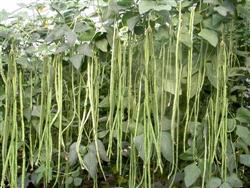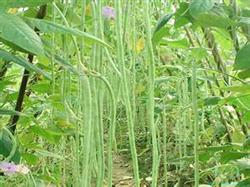Cultivation techniques for High yield of Bean

Beans are also called cowpeas, and their habits and cultivation techniques are similar to those of kidney beans. Although the growth characteristics of beans are rhizobium can fix nitrogen, but they are harvested from tender pods and tender beans, so nitrogen supply is indispensable, especially in the early stage. The trace element molybdenum can promote the vigorous development of root nodules, and legumes are also sensitive to trace elements such as boron and zinc, so spraying boron fertilizer, molybdenum fertilizer and zinc fertilizer on the basis of reasonable application of N, P and K fertilizer plays a certain role in improving podding rate, grain fullness and yield of legumes. Let's talk about the high-yield cultivation techniques of beans. Because the root system has rhizobium is aerobic, which is also one of the reasons why kidney beans can withstand short-term soil drought and poor moisture tolerance. First, it is appropriate to sow and choose fields that have not been planted with beans, and the continuous cropping land should be disinfected, because the repeated cropping land is very prone to root rot and Fusarium wilt, causing withered beans and dead vines, which is difficult to control. 1. Disinfection. ① retted the field with 60kg quicklime per mu and drained and whitened the soil after 7h for 10 days, and ② could use 500x solution of potassium permanganate or bean fungus to wet the soil more than 3cm deep before planting (you can also use chlorpromazine or carbendazim 2) + Beilin (Jiajia iodine). 2. Choose to make ridges according to the soil fertility, with a width of about 40 cm and a height of 30 cm. Open a small trench 10 cm deep on the ridge surface, and drench it with 1000 kg of rotten dung water per mu. After tanning, loosen the soil, select suitable varieties, soak the seeds with water after 4 hours, mix the seeds with chlorothalonil powder, 25 grams of powder for every 500 grams of seeds, sow seeds in a small ditch, plant in a single row, sow two seeds every 20 centimeters, cover them with soil fertilizer or burn the soil, and sprinkle with water. Second, seedling management sowing two days later, according to the dry and wet conditions of the ridge surface, lightly drench water to ensure the water needed for seedling emergence. After 5-6 days, when the bean seedlings have two leaves in one heart, drench once with jinggangmycin 800 times and 750 kg per mu to prevent and cure root rot, blight and other diseases. Seedling in time, guarantee one plant every 20 centimeters. Be careful not to touch the plant when using the medicine. Fertilize properly according to the growth of bean seedlings, use urea 3kg / mu, add the same amount of potassium fertilizer to water 1000kg ~ 1500kg, and sprinkle with thin water after application. The prevention and control of bean thrips is the focus of the seedling stage, bean thrips harm young heart tips, that is, common untapped extraction, only two leaves, commonly known as "blind heart". The control of thrips can be treated with isocarbophos 600x plus isocarbophos 600x, avermectin 1500 times plus imidacloprid 1500 times, or good winter 500x plus 5% fipronil 1500 times, sprayed once every 6 days and sprayed twice at seedling stage. Third, vine management bean seedlings have vine extraction, to carry out large cultivation of soil, combined with fertilization, 30 kg of phosphate fertilizer plus 10 kg of urea per mu, evenly applied on both sides of the ridge, cover fertilizer and weeds with furrow soil, pay attention to fertilizer and soil do not touch beanstalk. If possible, 2000 kilograms of barnyard manure can be applied per mu to cultivate soil on the edge of the ridge. After cultivating the soil, drench once with thiamine mixture, add 1000 kg of water with 1 kg of copper sulfate and 2 kg of carbamine per mu. At the same time, the vine is put on the shelf, usually with a herringbone frame. When the seedlings are prosperous and long, a conical frame can be used, that is, every 40 cm, three bamboos are inserted into equilateral triangles, the ridges are tied into cones, and the upper frame is horizontal bamboo. In order to facilitate operation, the height of the scaffolding should be controlled within 2 meters. The conical frame can increase the yield by more than 10% compared with the herringbone frame. Control moisture, run horse water every 3 days in sunny days, wet ridge surface at the same time, pay attention to drainage in rainy days. The main diseases and insect pests in the vine period are rust, powdery mildew, bean thrips and bean borer. You can use trimethophos (800-500 times) plus isocarbophos 500 times plus an Lubao 800 times, or Xiansheng 600 times plus omnipotent powder 600 times plus Yisuli 800 times, pay attention to the concentration of fenrust Ning from light to dense (800 times 500 times), spray once every 7 days, and spray Yunda 120 every 14 days. 4. harvest time management sowing for about 60 days, the plant enters the reproductive growth, and the harvest time appears, fertilizing every 7 days, using 10 kg compound fertilizer plus 5 kg urea per mu, mixed with 100kg manure for 3 days, adding 1500 kg of water to the ridge surface, sprinkling thin water after application, or applying 20 kg compound fertilizer plus 10 kg potash fertilizer and 10 kg urea per mu under the opening hole 35 cm away from the ridge. Apply one side of each ridge and apply the same amount of fertilizer on the other side after 10 days. The hole should be drenched with enough water before application, do not drench water on the ridge surface within two days after application, and do not apply fertilizer on rainy days. 1-2 cm water should be kept in the furrow during the harvest period. Pest control can choose the following agents to control spot blight and blight: 75% chlorothalonil 600 times plus 70% mancozeb 600 times; rust and powdery mildew: 50% colloidal sulfur 300 times, 1000 kg liquid per mu, but only if there is no disease, prevention is better than cure. The main pest is bean borer, which can be used: ① 1000 times plus imidacloprid 1500 times, ② avermectin 1500 times plus an Lubao 600times, ③ 1000 times plus small insect enemies 800times. The above three agents should not be mixed with fungicides. As the control of bean borer is very difficult, the spraying time should be sprayed every 3-4 days, and it is better to spray bean blossoms before 10:00 in the morning. Add 120 cloud spray every 7 days. It is advisable that the harvest should not be dry in the morning.
- Prev

How to treat the dried leaves of beans suddenly?
The main results were as follows: (1) the improved varieties were selected and sowed at the right time, and the main varieties with better performance were cowpea 28mur2, Zhangtang bean, red mouth swallow, open field direct seeding in mid and late April, seedling transplanting from late March to early April, and summer sowing from late May to early June. (2) soil preparation and fertilization.
- Next

There are ways to achieve high yield of beans.
1, beans can be direct seeded, can also be seedlings transplanting, generally seedlings transplanting, through seedling transplanting, can appropriately inhibit vegetative growth, promote reproductive growth. Selecting good land, applying base fertilizer, watering properly, using disease-resistant seeds and dressing seeds with new high-fat membrane can ward off underground diseases and insects, isolate virus infection and do not affect germination.
Related
- Where is it suitable to grow horseradish in China? it is expected to see the middle altitude horseradish in Alishan.
- How to prevent tomato virus disease reasonably? (Control methods included)
- Many people like to plant towel gourd on the balcony. What are the main points of this method and management?
- What crops can chili peppers be mixed with?
- Fertilization techniques and matters needing attention in Tomato
- What are the grafting techniques for peach seedlings in spring?
- Harm and control methods of root swelling disease of Chinese cabbage
- What are the pests of sweet potatoes? How to prevent and cure it?
- Symptoms, causes and Control methods of navel Rot in Tomato
- The cause of "Cucumber rotten bibcock" in Farmers' planting Cucumber and its Control Plan

